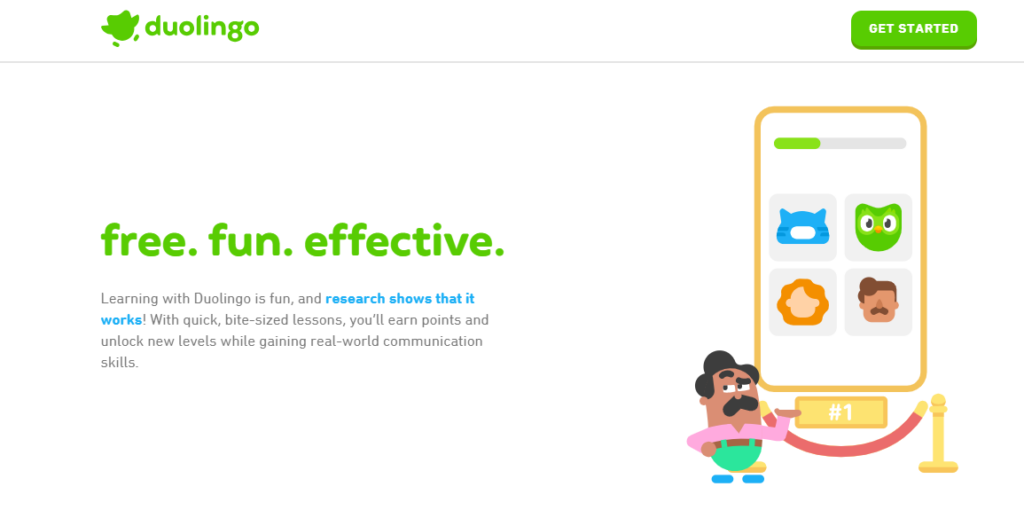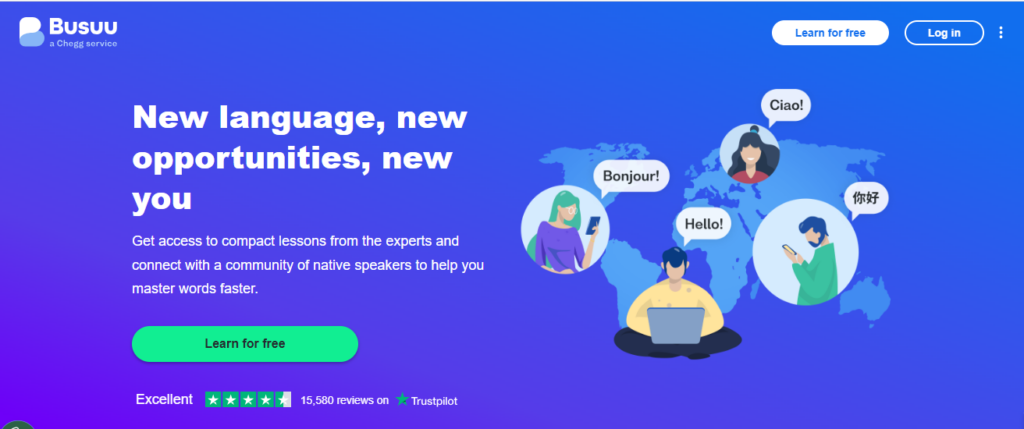The 10 Best Language Learning Apps for 2024
Coming up: cartoon owls, speaking and listening, taking care of children, and the world’s 10 best language learning apps.
Presumably, you’re here because you want to learn a language (yep, you’re right—we have good instincts here at Homelike).
So in this guide, we’ve brought you some help… and we’ve covered the world’s 10 best language learning apps (along with details on what they offer, how they differ, and who’ll like using each one).
Expect fun stuff, not-so-fun stuff, apps for beginners, and options to test even intermediate speakers.
Bring your thinking cap and come join the party!
FEATURED APP: Ling
Best for: a comprehensive approach to language learning with engaging and interactive lessons.
Ask anyone about effective language learning apps, and the Ling app often comes up as a top contender.
For many, Ling is an excellent choice for diving into a new language that uses gamification technique. Ling begins with the basics (covering common words and phrases), then gradually progresses to more complex concepts and sentences.
Anticipate a mix of interactive exercises, colorful visuals, playful monkey mascott, and a variety of engaging activities. If you’re looking to make language learning enjoyable and interactive, Ling is a great option.
It offers a wide range of languages: standard choices like Spanish, French, and Chinese, as well as more unique options like Serbian, Tagalog, and even lesser-known languages such as Khmer. While the free version includes some ads, they’re generally unobtrusive.
The Best Language Learning Apps: Our Top 10 Picks
1. Duolingo
Best for: picking a well-known name, and making language learning into a big fun game
Ask basically anyone about the best language learning apps, and they’ll always recommend Duolingo.
… and for most people, it’s the best place to begin.
It starts off super basic (testing words like ‘me,’ ‘house,’ mum,’ and ‘dad’), before then gradually moving to some surprisingly-tricky territory.
Expect cartoons, repetition, big splashes of color, an owl-faced mascot, and a wide variety of game-like exercises. If you want to turn a chore-like task into a fun task, Duolingo is for you.
You have a huge number of language choices: standard options include Spanish, German and Italian, while leftfield (and sometimes very-leftfield) options include Latin, Vietnamese, and… Klingon.
The free version has adverts, but they’re not too disruptive.

2. Babbel
Best for: going from 0 to 100, learning local slang, and the best complete package
For getting all immersive, Babbel is as good as it gets.
It isn’t as fun as Duolingo, there’s no real gamification, and the free lessons are VERY limited.
… but if you’re serious about wanting to learn, Babbel is the place to go.
Although it starts off pretty easy, the learning curve is quite steep. In-depth features include slang, insights into local customs, and lots of listening—and people who’ve already learned a language will find the methods pretty productive. Get this: Babbel also offers live classes, for when you have a good grasp of the basics.
3. Rosetta Stone
Best for: serious people, lots of speaking, and getting repetitive
The third of the well-known options, Rosetta Stone is among the best language learning apps for practicing pronunciation.
Yeah, many apps will listen as you attempt your way through a sentence…
… but Rosetta Stone’s tech is a bit more advanced, so it picks up subtle nuances (and gives relevant feedback).
Other features include captioned photos, themed courses and units, live lessons, and story-based audio clips.
Because it’s so detailed, you could go all the way from beginner to intermediate using nothing but Rosetta Stone. But in some ways, it’s pretty similar to Babbel—it’s not particularly fun, and its vaguely-tedious approach will appeal to serious learners rather than fun-seekers.
Uniquely, it doesn’t actually offer translations. Instead, it works under the impression that learners will use their intuition to work out the meanings of words—immersive but frustrating.
Be warned though: Rosetta Stone is a lot pricier than most other options.
4. Lingoda
Best for: learning from real people, and actually taking classes
If you want some *actual* language classes, Lingoda is for you.
Their online classes are live, they include speaking and listening, and you get an actual real-life teacher to give you actual real-life advice. It’s a certified online language school, and it gives out various certificates.
(So, in truth, Lingoda is way more than just a standard language app).
It’s very easy to get started: you choose a course, you choose a level, and you choose the vocabulary and themes relevant to what you want to learn.
You can choose both group classes (max 5 participants per class), and 1-on-1 classes.
5. Preply
Best for: combining game-like stuff with real-life teachers
One of the best language learning apps for flexibility and variety.
With Preply, you get courses, flashcards, and game-like content. But you also get 1-on-1 lessons with tutors.
To choose a tutor, you search through profiles of potential options, and choose one based upon your preferred learning style.
Some of the in-person classes are unbelievably cheap—ideal for real-life learning on a budget.
6. Pimsleur
Best for: nailing pronunciations, and getting ready for conversation
Mainly used for speaking and listening, Pimsleur is excellent for practicing conversational skills.
It’s not particularly exciting, there isn’t much variety, and you don’t really learn much grammar—but if you’re keen to maintain a chat, Pimsleur is for you.
The dialogue uses real-life conversations, and it’s based on real-life settings (so you’ll learn practical stuff; not just textbook examples with no real use). And because it offers more than 50 languages, it’s surprisingly versatile.
You get one free lesson, but you need to pay for more.
7. Memrise
Best for: lots of learning methods, and listening to locals
Another of the best language apps for casual conversation, Memrise offers a multi-faceted approach with a load of learning options.
Expect flashcards, grammar lessons, speaking and listening, and short videos of local people speaking their native language (so you can hear how things are really pronounced—not just how a robot does it).
Overall, a good combo for balancing reading, writing, and listening.
8. Busuu
Best for: learning from locals, and receiving specific feedback
Uniquely, Busuu pairs you up with a native speaker of whichever language you’re learning*. This native will comment on your work, give corrections, and help you to improve—and you can give the same help to people learning your native language.
Other features include friend-adding, live group classes, 1-on-1 lessons, audio recordings, games, and true-or-false sessions.
*Important note: there’s one major downfall of this approach: there’s no guarantee the feedback you’re getting is accurate. But let’s be honest—a native speaker is probably gonna know what they’re talking about (hopefully).

9. Lirica
Best for: learning to listen, and bopping along to music
Here’s a strange option.
The Lirica approach is completely music-based. You listen to music, you translate parts of that music, and you play games with the lyrics. Quirky!
Okay, you shouldn’t use Lirica as your only tool (it won’t teach you much on its own), but it’s a fun and unusual way to learn, and many users like the novelty. But if you’re a ‘serious’ learner (and want to learn about grammar and sentence structure), it’s not for you.
Some content is available for free, but you need to pay for anything detailed.
Note: Lirica is available in only 3 languages—English, German, and Spanish.
10. Drops
Best for: quick sessions, playing games, and learning vocabulary
One of the best language learning apps for game-lovers, Drops features a pretty interface, mini crossword puzzles, image-to-text matches, and anagrams.
Each lesson lasts only five minutes (a burnout-prevention tactic), and it focuses exclusively on vocabulary
Overall, it won’t make you fluent—but it’s great for quickly picking up lots of useful words.
The basic program is free, and includes a surprisingly-good amount of depth.
Drops offers more than 50 languages… including some pretty niche stuff, like Ainu (a Japanese language) and Igbo (a Nigerian one).
3 Other Ways to Learn Languages
You don’t *need* to use apps to learn languages.
Instead, you can do things how we did them in the good old days, before we all had a smartphone. Three of the best non-app methods are:
Living in a country!
Let’s be honest—if you’re gonna learn a language, living in a country where it’s spoken is undoubtedly the best way to do it (well, assuming you already have a basic foundation).
Nothing will make you learn a language better than living in it. Making friends in it. Navigating grocery stores with it. Asking for directions with it. Trying to tackle bureaucracy with it. Reading store fronts and road signs with it.
… so, if you have the time and the flexibility, that’s what we recommend.
‘Woah, that sounds pretty good! But wait a second—where would I live?’
Well, we have loads of comfy homes on our site, dotted around various parts of Europe (and in New York City!). They’re all central, affordable, fully-furnished, and ready to move into today—and if you move in today, you can be learning a language tomorrow.
We’ll sort the housing, so you can work on learning the language. Easy.

Going to a language learning center
Some people prefer to learn languages with in-person classes.
If that’s you, go to a language learning center. These function just like a college, or a school, or any other educational establishment you’ve ever been to. You attend classes with other students, you learn the language, and you get assignments, tasks, and chances to answer questions.
You can find these language centers in pretty much any major city on the planet. But here are a few examples, for a bit of inspiration:
- Berlin: some of the best options are die deutSCHule, speakeasy Berlin, and GLS Berlin.
- London: check out Edwards Language School, and The London School of English.
- Paris: good options include Ecole Suisse, Eurocentres Paris, and French As You Like It.
- Barcelona: top picks include Speakeasy Barcelona, Olé Barcelona, and Expanish.
- Vienna: two well-respected options are DeutschAkademie, and ActiLingua Academy.
For more information on those cities, check out our neighborhood guides to Berlin, London, Paris, Barcelona, and Vienna. Cos once you move there, you’ll need to know where to live!























